Beef prices are projected to continue increasing as U.S. beef production declines with no signs of a cattle herd rebuild. Additionally, cheap beef may soon become further out of reach…
An Overview of U.S. Farms From USDA’s Economic Research Service- 2022 Edition
The USDA’s Economic Research Service (ERS) recently released its annual report exploring characteristics of U.S. farms: “America’s Farms and Ranches at a Glance, 2022 Edition.” Today’s update includes highlights from the report, which was written by Christine Whitt, Noah Miller, and Ryan Olver.
The report noted that, “In total, family farms accounted for about 98 percent of total farms and 83 percent of total production in 2021.”
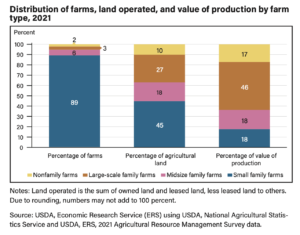
“Nonfamily farms accounted for the remaining 2 percent of farms. Although the percentage of nonfamily farms has remained the same from 2020 to 2021, the farms’ value of production increased from 13 percent in 2020 to 17 percent of production in 2021.”
With respect to commodity production, ERS explained that, “Large-scale family farms produced most of the values of cotton (73 percent), dairy (69 percent), and cash grains and soybeans (51 percent) in 2021. Small family farms produced the majority of hay (53 percent).”
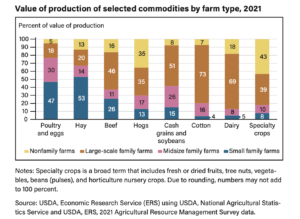
In a closer look at profitability, the report indicated that, “Large family farms were most likely to have OPMs [Operating Profit Margin] in the low-risk (green) zone (OPM of at least 25 percent)— at 54 percent—and least likely to be in the high-risk zone in 2021 at 25 percent. These farms are more likely to have positive on-farm income.”
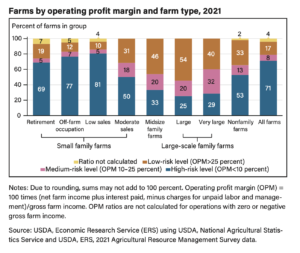
In a closer look at government payments, the ERS report indicated that,
The distribution of commodity-linked payments and other payments is similar to the contribution to the total value of production.
“Mid- size and large-scale family farms and nonfamily farms accounted for 82 percent of the total value of production and received 78 percent of commodity-linked and agricultural disaster programs, and other Federal, State, and local farm program payments.
“Small family farms received 36 percent of all farm-level pandemic assistance from USDA and 22 percent of all other Government payments—excluding pandemic assistance and conservation program payments—which was consistent with the farms’ small (18 percent) production scale. Large-scale family farms received 31 percent of all farm-level pandemic assistance and 39 percent of all other payments.”

“Almost 20 percent of all U.S. farms received some sort of pandemic assistance,” the report said.
“Overall, 34 percent of all farms reported receiving some type of Government payment in 2021, which is a decline from 40 percent in 2020.”
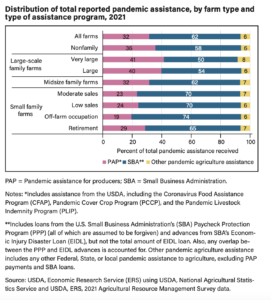
With respect to Federal crop insurance, ERS stated that, “Indemnities from Federal crop insurance were roughly proportional to the acres of harvested cropland and concentrated among midsize and large-scale farms in 2021.
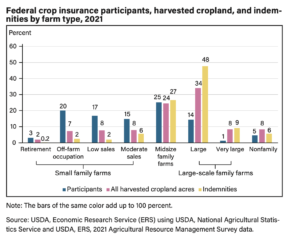
“Overall, 14 percent of U.S. farms participated in Federal crop insurance programs, but participation rates varied widely across farm types. In 2021, 62 percent of farms producing row crops (cotton, corn, soybeans, wheat, peanuts, rice, and sorghum) purchased Federal crop insurance.”





